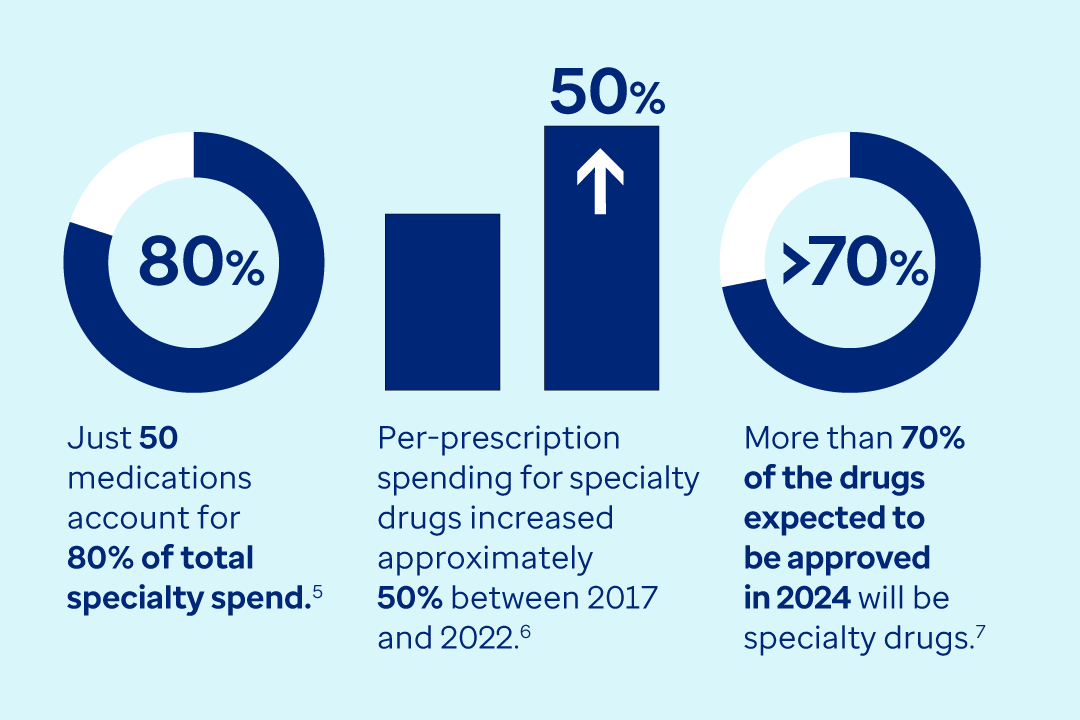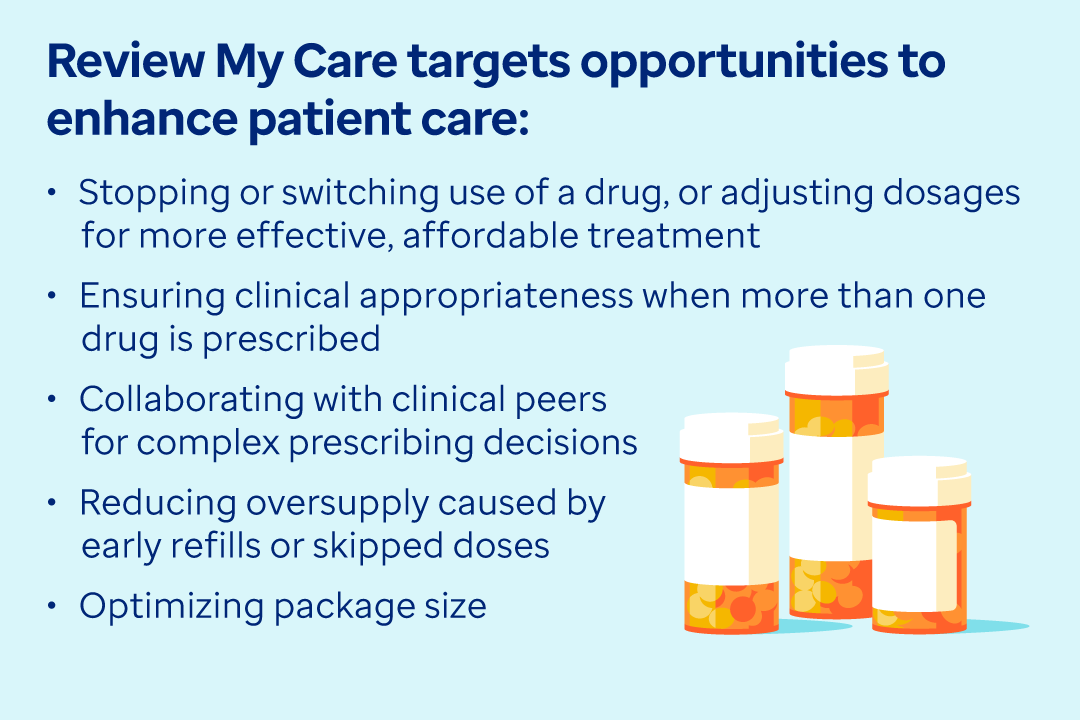Better, more efficient use of specialty drugs
Following specialty patients throughout their care is key to cost-effective use of high-cost drugs.
In the pharmacy benefits world, we typically think of non-adherence in terms of people not taking their medications as prescribed. It is that, but non-adherence also includes other aspects of care, including patient follow-up visits.1
Non-adherence has many causes. There may be practical barriers, such as the financial difficulties and the complexity of the therapy. There may also be issues in the patient’s life, such as cultural beliefs, alcohol use, depression, anxiety or reduced cognitive abilities.2
Regardless of why, non-adherence causes many problems. Overall, non-adherence to therapy leads to preventable hospitalizations and deaths and costs the U.S. health system half a trillion dollars every year.3
Patient follow-up for specialty drugs
Now let’s zero-in on specialty medicines. Specialty drugs are often high-cost, limited distribution medications that are used to manage rare, chronic and complex medical conditions.
These drugs require more intensive patient management, since patients may require financial assistance, dosing instruction and counseling.4 As such, adhering to a continuously monitored care plan becomes even more important.

- Donut chart illustrates that just 50 medications account for 80% of total specialty spend.5
- Bar chart shows per-prescription spending for specialty drugs increased approximately 50% between 2017 and 2022.6
- Donut chart shows more than 70% of the drugs expected to be approved in 2024 will be specialty drugs.7
The Academy of Managed Care Pharmacy specifically calls out the need to closely monitor patients as part of their definition of what distinguishes specialty drugs. Some reasons include:8
- Managing specialty pharmaceuticals can require high technology diagnostics to determine treatment outcomes.
- Specialty drugs typically require intense clinical monitoring to manage severe side effects and frequent dosage adjustments.
- Due to the high costs of these treatments, carefully monitoring the patient’s response can help minimize excess or wasted utilization of resources.
What's the problem?
We’ve just looked at some of the good reasons for following a care plan that includes regular patient follow-up. However, at Optum Rx we are observing significant numbers of members — upwards of 30% — who are not seeing their providers for follow-up in a timely fashion after they’ve begun their treatment.
Why is this important? In addition to the overall health outcomes described, we have also found that almost half of all specialty therapies present an opportunity to stop or adjust therapy within 18 months of the beginning of therapy.9

Review My Care targets opportunities to enhance patient care: Stopping or switching use of a drug, or adjusting dosages for more effective, affordable treatment; ensuring clinical appropriateness when more than one drug is prescribed; collaborating with clinical peers for complex prescribing decisions; reducing oversupply caused by early refills or skipped doses; optimizing package size.
A closer look at the rationale behind Review My Care
We noted that specialty drug patients often need to adjust their therapy. As people undergo changes in their condition, they may need different doses of their medication, or a new drug entirely. This requires close patient follow-up.
We can get a good illustration of the need for consistent patient follow-up by considering widely used clinical treatment guidelines. In this case we’ll look at some of the guidelines used in treating multiple sclerosis (MS).
Multiple sclerosis is considered an “unpredictable” disease that disrupts the way information moves in the brain, and from the brain and the body. As such, symptoms not only vary from person-to-person, but from day-to-day and year-to-year.10 This high variability makes MS a good candidate for the Review My Care approach.
Adding to the changeable symptoms are the drugs used to treat MS, which are also quite complex. MS is often treated with disease-modifying therapies (DMTs). While not a cure, these drugs are designed to slow or reduce the progress of the disease.11
The decisions around how to treat with DMTs are very complex. Of course, every drug comes with its packet of U.S. Food and Drug Administration (FDA)-approved indications for use. But in addition, there are national and international professional associations that provide physicians with detailed treatment guidelines. There are additional professional groups dedicated just to describing all the factors that govern the use of imaging in the diagnosis of MS.12
One of the key underlying themes of all these recommendations is time. Treatment and imaging of various types should be performed at highly specific points and intervals. For example, imaging should occur when people begin a new drug, after they have used it for a set period, or when they switch to another drug, among many other variables.13
One of the variables to watch for is when a new drug enters the class that may be more suitable for a given patient. This can affect any disease category, but MS in particular has a busy development pipeline. At least 10 new drugs or new indications are in various stages of development and testing right now.14
Any of these MS therapies that can make the jump to FDA approval could potentially trigger a new update to a patient’s treatment.
In light of so many potential opportunities to adjust or change MS treatments, it’s easy to see the problem in having 30% of patients who are not seeing their providers for timely follow-up care.
Special drugs need special programs
Clearly, we need to keep careful tabs on patients who use specialty drugs. And one might ask, aren’t pharmacy benefit managers (PBMs) overseeing patient monitoring as one component of their utilization management (UM) function?
This isn’t the case. Utilization management consists of steps like prior authorization, step therapy and supply limits. These are necessary measures aimed at managing drug access at the beginning of therapy. They help ensure that patients receive the right drug for their condition in the most efficient way.15
But in addition to traditional UM, most PBMs, including Optum Rx, have dedicated specialty clinical programs. However, similar to UM, existing specialty clinical and member engagement services are aimed at members new to treatment. They prioritize assistance in condition management, adherence, answering questions, and educating patients in what to expect from their new treatment.
In contrast, the Review My Care program focuses on treatment-experienced members, and specifically those with a higher likelihood of cost containment opportunities. Review My Care is laser-focused on maximizing specialty pharmacy benefit performance in real time among members who have been on their treatment for longer than 3 months. (Most often patients have been in treatment for 6 to 12 months or longer.)
Care ambassadors
Our world-class data and analytics capabilities are at the heart of Review My Care. Our analytics capabilities enable us to — at the drug level — identify specific opportunities for cost reduction. Examples include adjusting dosing, recommending alternatives that may not have been available when treatment began, or identifying therapeutic duplication or oversupply.
However, health care is more than algorithms. Real people — often facing one of the biggest challenges of their life — need care and attention beyond just drugs.
Therefore, the face of this program is a new role, the care ambassador. We believe that this is the first role of its kind in the specialty pharmacy services and PBM industry.
Optum Rx care ambassadors go beyond traditional member outreach. Care ambassadors are specially trained to consider formulary strategy and benefit design in addition to more customary concerns like clinical safety and efficacy. Their goal is to drive cost savings and enhanced clinical efficacy for both the member and plan sponsor.
In practice, Review My Care care ambassadors conduct specialty drug value assessments with members who demonstrate an opportunity to optimize treatment. Then they help coordinate with prescribers to make changes when clinical and financial considerations warrant.
Program performance is measured through retrospective claims analysis that follows what happened to their specialty drug therapy after the consultation. Examples of successful outcomes include drug discontinuation, dose adjustment, switching to a therapeutic alternative, or switching to a different manufacturer or package size.

Review My Care outcomes
- 66% member engagement rate
- >$18k average annual savings per successful intervention
- $1.17 average PMPM drug cost savings
Reference: Optum Rx. 2023 Review My Care Internal Book of Business Program Data.
Part of a comprehensive specialty management strategy
Review My Care complements our existing Specialty Standards strategy, which delivers a proactive, modernized strategy to optimize pharmacy spend. Review My Care complements this strategy by providing ongoing monitoring and interventions when an opportunity is identified in our analytics, and as the member’s specialty treatment evolves or the drug landscape changes.
Review My Care ensures that patient care is combined with a cost optimization strategy to provide a truly holistic specialty cost containment solution.
To learn more about Optum Rx specialty cost management programs, please ask your consultant or Optum Rx representative.
Related healthcare insights

Article
Old strategies and new challenges don’t mix. Future-proof your plan and get better predictability with new pricing models and risk management tools.

Article
Orphan drugs offer hope to people with rare diseases. They also add large costs. Our Orphan Drug Program is a targeted strategy to help control costs.

E-book
Specialty drug spend is a “top threat” to employer-provided benefits. Discover sustainable savings with your existing Optum Rx plan.
Sources
- ChenMed. Empowering Patients to Improve Care Plan Adherence. Published May 18, 2023. Accessed May 15, 2024.
- Ibid.
- PSQH. The Impact of Cost on Medication Adherence. Published May 9, 2022. Accessed May 15, 2024.
- Patient Advocate Foundation. What’s So Special About Specialty Pharmacy? Accessed May 15, 2024.
- Optum Rx. Internal book of business data. 2022.
- U.S. Department of Health and Human Services. Competition in Prescription Drug Markets, 2017-2022. Published December 2023. Accessed April 30, 2024.
- Optum Rx Pipeline Database. Accessed April 2024.
- Academy of Managed Care Pharmacy. Specialty Pharmaceuticals Concept Series. Published July 18, 2019. Accessed April 30, 2024.
- Optum Rx Internal Data P&T External Consultant interviews. January 2022.
- National Multiple Sclerosis Society. What Is Multiple Sclerosis? Accessed May 29, 2024.
- Medscape. Multiple Sclerosis Guidelines. Updated March 12, 2024. Accessed May 28, 2024.
- Ibid.
- Ibid.
- Verywell Health. Experimental Therapies for Multiple Sclerosis (MS). Updated on June 30, 2023. Accessed May 28, 2024.
- JAMA Health Forum. Pharmacy Benefit Managers. Published November 3, 2023. Accessed April 30, 2024.
